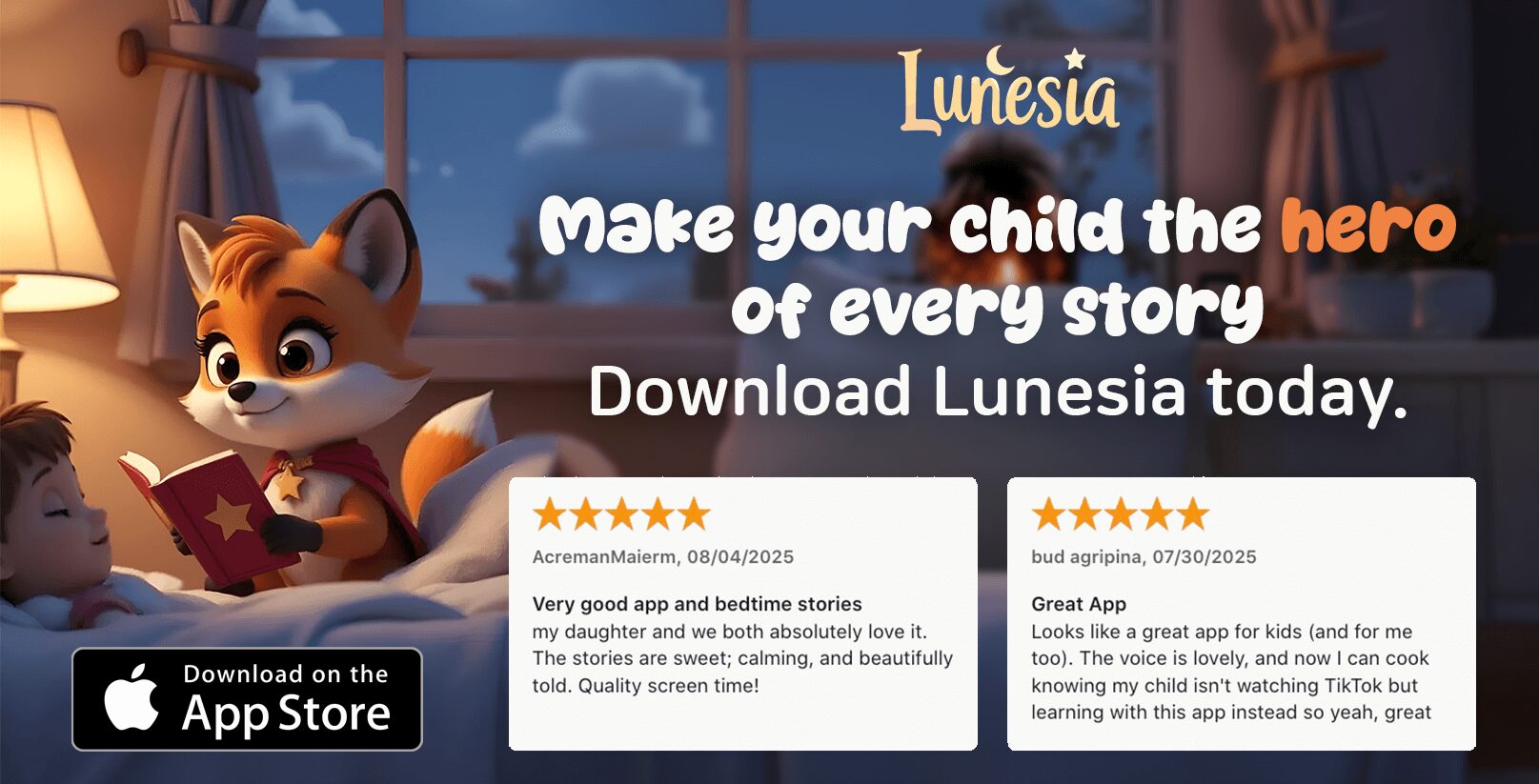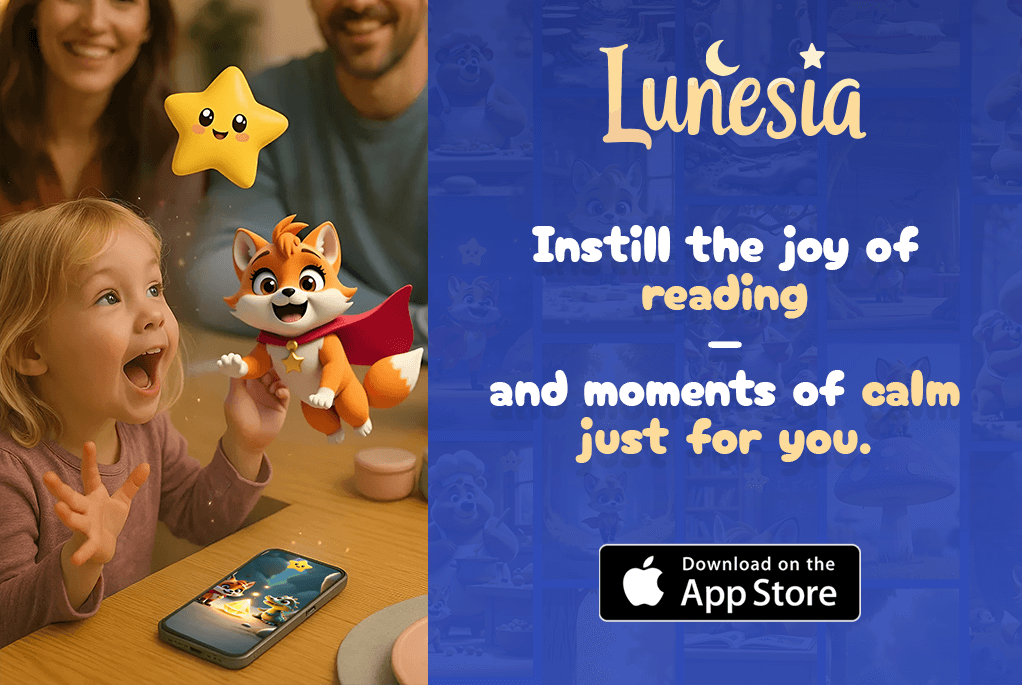As a parent and child development specialist, I’ve often wondered: What’s the best way to help our children wind down before bed? Is it a passive TV show, or something more engaging?
Traditional screen time before bed can interfere with quality sleep. That’s why I’ve discovered the power of bedtime stories in creating a calming pre-sleep routine. Bedtime is an opportunity for bonding and relaxation, not just a time for kids to sleep.
Stories have a way of engaging young minds, fostering a love for reading, and creating a soothing atmosphere. In this article, we’ll explore how interactive stories can be a game-changer for bedtime routines, and discuss various types of books and digital experiences designed to help your kids relax.
The Problem with Screen Time Before Bed
As we wind down before bed, it’s common to reach for our screens, but this habit can have unintended consequences on our sleep. Many of us are unaware of the impact that screen time has on our ability to fall asleep and stay asleep throughout the night.
Using devices before bedtime exposes us to bright screens and blue light, which can suppress melatonin production and interfere with our sleep-wake cycle. This can lead to difficulty falling asleep, reduced sleep quality, and increased daytime fatigue, especially in children.
How Blue Light Affects Sleep Quality
The blue light emitted from screens disrupts the production of melatonin, the hormone responsible for regulating sleep cycles. This makes it harder for children to fall asleep naturally, as their bodies are tricked into thinking it’s still daytime.
Passive vs. Active Engagement Before Bedtime
While watching TV is a passive activity, interactive stories engage the brain differently. Active engagement can be beneficial if done correctly, as it can help wind down and prepare for sleep. However, passive screen time can stimulate the brain, making the transition to sleep more difficult.
Why Interactive Stories Pre-Sleep Are Game-Changers
Interactive stories are revolutionizing bedtime routines for kids. By creating a special transitional space between daytime activity and nighttime rest, these stories help children’s bodies and minds prepare for sleep. The right bedtime mood is crucial for quality sleep, and interactive stories can help shift kids from excited or anxious states to calm, sleep-ready states.
Creating the Right Bedtime Mood
A calm bedtime mood is essential for a good night’s sleep. Negative emotions accumulated during the day are processed by the brain during sleep, making it harder to fall asleep if we’re not in the right mood. Interactive bedtime stories can help create a soothing atmosphere, making it easier for kids to wind down.
Engaging Multiple Senses for Better Wind-Down
Interactive stories engage multiple senses, including touch, sight, and hearing, creating a more immersive wind-down experience. This multi-sensory engagement helps promote relaxation rather than stimulation, making it easier for children to fall asleep. The physical interaction with books or storytelling apps also creates a different neurological response than passive screen viewing.
| Benefits of Interactive Stories | Traditional Bedtime Stories |
|---|---|
| Engages multiple senses | Often passive |
| Promotes relaxation | Can be stimulating |
| Tailored to address specific bedtime challenges | One-size-fits-all approach |
The Science Behind Effective Pre-Sleep Routines
Understanding the science behind pre-sleep routines can revolutionize how we approach bedtime. Consistent bedtime activities signal to the brain that it’s time to prepare for sleep. This consistency is crucial for developing healthy bedtime habits.

Interactive activities, such as bedtime stories, engage the brain’s executive function in a way that’s stimulating yet calming. This balance is essential for helping children relax and prepare for sleep.
How Interactive Activities Calm the Mind
Interactive storytelling can calm the mind by engaging it in a pleasant activity. This engagement distracts from the stresses of the day and focuses the mind on a calming narrative, helping individuals, especially children, to unwind and fall asleep faster.
By incorporating interactive elements, such as choosing what happens next in a story, the mind is gently stimulated without being overwhelmed. This can lead to a more relaxed state, preparing the body for sleep.
Building Positive Sleep Associations
Building positive sleep associations is crucial for developing healthy bedtime habits. Interactive bedtime stories can create these positive associations by linking the bedtime routine with feelings of safety and relaxation.
Even short sessions of 15-20 minutes of interactive storytelling before bed can significantly improve sleep quality when done consistently. This consistency helps reinforce the positive associations, making it easier to fall asleep.
Interactive Books That Transform Bedtime
Discover how interactive books can turn bedtime into a delightful experience for both you and your child. These engaging stories not only captivate young minds but also create a special bonding time.

Press Here by Hervé Tullet
Press Here is a pioneering interactive book that has transformed bedtime reading. Its simple yet brilliant concept invites children to press, shake, and tilt the book, creating a sense of magic and agency. You can find more interactive books like this one on Read Brightly.
Who’s Hiding? Interactive Board Book
This interactive board book encourages gentle problem-solving and observation skills as children look for clues and guess which animals are hiding behind the flaps. Humorous visual clues make it a funny interactive experience.
Boop the Snoot Interactive Board Book
Boop the Snoot creates a delightful tactile experience for toddlers, allowing them to use their natural poking instinct in a structured way. It’s a great way to engage your child before sleep.
Interactive Stories That Encourage Movement and Relaxation
Using movement-based interactive stories before bed is a counterintuitive approach that actually works. It helps children release excess energy in a controlled way, making it easier for them to wind down.

Shake Your Booty Interactive Book
Shake Your Booty Interactive Book combines fun physical movements with a wind-down structure. Kids shimmy, shake, wiggle, and stomp along to cheerful instructions, learning about their body parts while getting their wiggles out.
The High Five Book
The High Five Book creates a special bonding experience between parent and child through interactive high-fiving. This funny interactive picture book about a high-five contest helps kids hone their high-fiving skills, gradually becoming gentler and slower, naturally leading to a calmer state.
How to Talk to Animals
How to Talk to Animals encourages vocal play through animal sounds that can be both energetic and then increasingly softer. This teaches children to modulate their energy levels, an essential skill for falling asleep easily.
These movement-based stories help kids become more aware of their body and learn to consciously relax it. By incorporating physical activity into bedtime stories, parents can create a more effective wind-down routine.
Interactive Stories That Prepare Children for Sleep
Interactive bedtime stories are revolutionizing the way children wind down before sleep. These stories are designed to mirror and reinforce bedtime routines, helping children mentally prepare for sleep through familiar patterns.
Ploof: A Little Cloud That Feels Shy
Ploof: A Little Cloud That Feels Shy is an interactive board book that helps children process emotions before bed. As you interact with the cloud, Ploof feels more confident and comes out of its hiding spot. This story teaches social-emotional skills to preschoolers, creating a sense of emotional resolution that makes falling asleep easier.
Help Bear Get Ready for Bed
Help Bear Get Ready for Bed uses mirroring to encourage children to follow along with Bear’s bedtime routine. Young readers will enjoy tucking Bear into bed and yawning with him as he settles down to sleep. This gentle story encourages children to drift into dreamland as they follow the same routine.
The Pirate’s Wish
The Pirate’s Wish is an interactive picture book that uses imagination and gentle interaction to help transition children from active play to quieter bedtime activities. Readers will wish on a dandelion, scare away a sea monster, and blow raspberries. This swashbuckling adventure subtly incorporates relaxation techniques that physiologically prepare children’s bodies for sleep.
These interactive stories not only entertain but also help children relax and prepare for sleep. By incorporating relaxation techniques and mirroring bedtime routines, they provide a comprehensive approach to winding down before bed.
Digital Interactive Stories That Don’t Disrupt Sleep
Digital interactive stories can be a great way to wind down before sleep, but how can we avoid disrupting our sleep patterns? Certain digital interactive stories are specifically designed to avoid the sleep-disrupting aspects of typical screen time.

Loóna App Features and Benefits
The Loóna app is an example of thoughtfully designed digital interactive storytelling. It uses dimmer, warmer colors to minimize melatonin suppression and combines interactive coloring, gentle storytelling, and soothing sounds to create a multi-sensory wind-down experience. Loóna’s features include sleep games, sleep stories, bedtime stories, and music & nature sounds playlists.
How Digital Stories Can Be Sleep-Friendly
Digital interactive stories can help reduce overall screen time by providing a structured, time-limited alternative to endless scrolling or video watching before bed. Features like breathing exercises integrated into digital stories can teach children self-regulation techniques that help them fall asleep more easily, both with and without the app.
By incorporating these sleep-friendly features, digital interactive stories can become a valuable tool for improving sleep quality. As we continue to explore the world of interactive stories, it’s essential to prioritize sleep-friendly design.
Age-Appropriate Interactive Stories
As children grow, their engagement with interactive stories evolves, making it crucial to choose age-appropriate options for an effective bedtime routine. “The right story can transport your child to a world of wonder, making bedtime a special bonding experience,” says a parenting expert. Selecting the right interactive story can be a daunting task, but understanding your child’s developmental stage can guide your choice.
For Ages 0-3: Simple Touch and Response
For babies and young toddlers, simple cause-and-effect interactions are ideal. Touch-and-response books with different textures or sound elements can captivate their senses. For example, books with buttons that make sounds or pages with various fabrics can engage young children and encourage exploration.
For Ages 3-5: Guided Imagination
Preschoolers benefit from interactive stories that incorporate guided imagination exercises. Books that ask children to pretend they’re animals getting ready for hibernation or stars twinkling in the night sky can foster creativity and relaxation. These stories help children develop their imagination while winding down before sleep.
For Ages 6+: Complex Interactive Narratives
Older children can engage with more complex interactive narratives, such as choose-your-own-adventure stories or tales that ask readers to solve gentle puzzles or answer questions about their day. These stories not only entertain but also challenge their minds, making bedtime a engaging and interactive experience.
By choosing age-appropriate interactive stories, you can create a consistent bedtime routine that adapts to your child’s growing needs, making it easier for them to wind down and prepare for sleep.
Creating Your Own Interactive Bedtime Stories
You don’t need special materials to create interactive bedtime stories; your imagination and a few simple techniques are enough. By involving your child in the storytelling process, you can make bedtime more engaging and help them wind down more effectively.

Simple Techniques for Parent-Led Stories
One of the simplest ways to make a bedtime story interactive is by asking your child to participate. You can ask them to make sound effects or movements at certain points in the story. For example, you might say, “Let’s hear the dog barking in the distance,” or “Can you show me how the rabbit hops?” This not only makes the story more engaging but also helps your child feel more connected to the tale.
- Use different voices for characters to add depth to the story.
- Encourage your child to predict what might happen next.
- Ask your child to point out objects or animals in the pictures.
Incorporating Personal Elements for Greater Engagement
To make bedtime stories even more engaging, you can incorporate elements that are personal to your child’s life. Using your child’s name, favorite toys, or recent experiences can make the story feel more relevant and exciting. For instance, you could create a story about a character who has the same name as your child or goes on an adventure with a favorite toy.
- Use your child’s favorite stuffed animal as a character in the story.
- Incorporate recent events or outings into the narrative.
- Create a story that takes place in a familiar setting, like your home or backyard.
By following these simple techniques and incorporating personal elements, you can create interactive bedtime stories that are not only fun but also help your child relax and prepare for sleep.
Integrating Interactive Stories Into Your Bedtime Routine
Establishing a consistent bedtime routine that incorporates interactive storytelling can make a significant difference in your child’s ability to wind down. As you consider adding interactive stories to your bedtime routine, it’s essential to think about the timing and consistency of this new addition.
Timing: When to Start the Wind-Down Process
Starting the wind-down process 30-45 minutes before the desired sleep time allows your child to gradually relax. This timeframe enables you to introduce interactive stories as a calming activity, signaling to your child that it’s time to sleep. For example, you could begin with a warm bath, followed by an interactive story, and then some gentle stretches before bed.
| Activity | Time | Purpose |
|---|---|---|
| Warm Bath | 30 minutes before bed | Relax muscles |
| Interactive Story | 20 minutes before bed | Calm the mind |
| Gentle Stretches | 10 minutes before bed | Release tension |
Creating a Consistent Routine
A consistent bedtime routine helps your child’s body and mind recognize sleep cues, making the transition to sleep smoother. To create a consistent routine, start by setting a regular bedtime and sticking to it, even on weekends. Then, incorporate activities like reading, storytelling, or gentle exercises that signal to your child that it’s time to sleep. For instance, you could follow this sequence: dim the lights, read an interactive story, and then sing a lullaby.
By maintaining a consistent routine, you’ll create a sense of safety and predictability that helps your child feel secure as they drift off to dreamland. Even in challenging situations like travel or illness, try to maintain the routine as much as possible to provide your child with a sense of stability.
Conclusion: Moving Beyond Passive Entertainment for Better Sleep
By replacing passive screen time with interactive stories before bed, parents can significantly improve their child’s sleep quality and overall bedtime experience.
This approach not only fosters healthier sleep associations but also strengthens parent-child bonds. The best part? You don’t need expensive materials or special training – just creativity, consistency, and a willingness to engage with your child.
I encourage you to experiment with different types of interactive stories to find what works best for your unique child. As you begin this journey, you’ll likely notice positive changes in their sleep patterns and bedtime experiences. Start tonight, and watch how interactive bedtime stories can transform bedtime into a cherished daily ritual.
FAQ
What age range are interactive books suitable for?
Interactive books are suitable for children of various ages, ranging from toddlers to kids around 8 years old. For younger children, ages 0-3, simple touch and response books are ideal, while older children can enjoy more complex narratives.
How do interactive stories help with bedtime?
Interactive stories can create a calming and engaging bedtime experience, helping children wind down and relax. By incorporating elements like movement and imagination, these stories can distract from the stresses of the day and prepare the body for sleep.
Are digital interactive stories safe for children before bed?
Some digital stories can be safe and even beneficial for children before bed, as long as they are designed with sleep-friendliness in mind. Apps like Loóna offer a range of interactive features that promote relaxation and calmness, without the negative effects of blue light.
Can I create my own bedtime stories?
Yes, you can create your own bedtime stories using simple techniques like incorporating personal elements and guided imagination. This can be a great way to make bedtime more engaging and meaningful for your child.
How long should the wind-down process be before bed?
The wind-down process should ideally start around 20-30 minutes before bed, allowing your child to gradually relax and prepare for sleep. This can involve a consistent routine that includes activities like reading, storytelling, or relaxation exercises.
What are some tips for making bedtime stories more engaging?
To make bedtime stories more engaging, try incorporating elements like movement, imagination, and personal touches. You can also use different voices, ask questions, and encourage your child to participate in the storytelling process.




